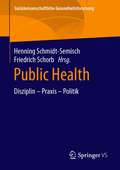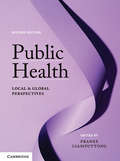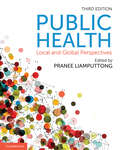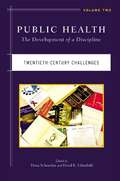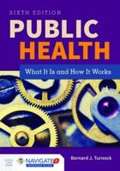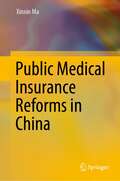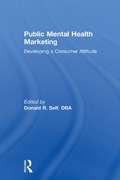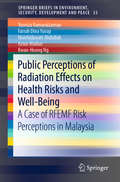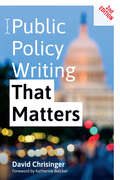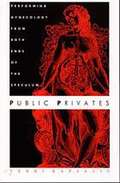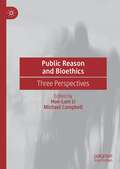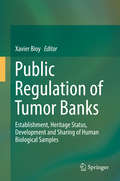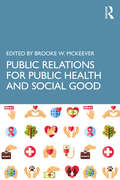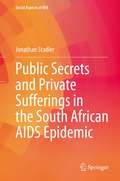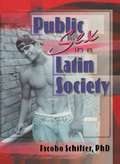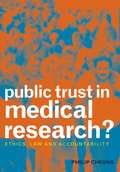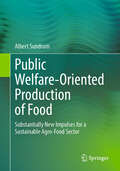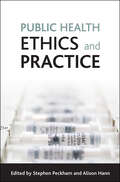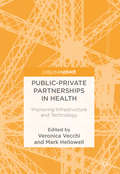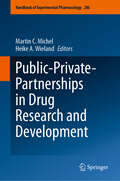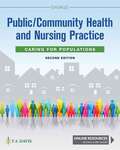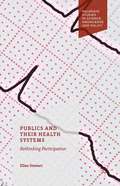- Table View
- List View
Public Health: Disziplin – Praxis – Politik (Sozialwissenschaftliche Gesundheitsforschung)
by Henning Schmidt-Semisch Friedrich SchorbVor drei Jahrzehnten begann sich Public Health an Universitäten und Hochschulen in Deutschland zu etablieren, und die Entwicklung des Faches kann heute allgemein als Erfolgsgeschichte gedeutet werden. Dennoch ist Public Health noch immer kein selbstverständlicher Teil des akademischen Fächerkanons, und auch das Verhältnis zur Politik ist unklar: Einerseits treten Public Health-Akteure dafür ein, dass Gesundheit in allen Politikbereichen berücksichtigt werden soll („Health in all Policies“), andererseits gilt zu viel Politiknähe als Gefahr für die wissenschaftliche Profilbildung.Die Beiträge dieses Bandes fragen in unterschiedlicher Art und Weise nach dem Stand der Disziplin Public Health sowie der entsprechenden Praxis und Politik: Welches Verhältnis hat Public Health zur Praxis von Gesundheitsförderung und Prävention? Kann Public Health heute als eine ‚Profession’ betrachtet werden? Welche disziplinären Zugänge finden sich in Public Health? Wie wirkt Public Health auf Politik ein, und wie beeinflusst – umgekehrt – Politik Public Health? Wie politiknah bzw. wie politisch soll Public Health sein?
Public Health: Local and Global Perspectives
by Pranee LiamputtongPublic Health: Local and Global Perspectives provides students with a comprehensive overview of Australian and international public health issues and contexts. It introduces the discipline of public health and aims to deepen students' understanding of the determinants of health, historical and theoretical perspectives of public health, current health research and evidence-based practice. This fully revised and expanded edition includes new chapters on ethics in public health, planning and evaluation, individual behavioural change, gender-based health inequalities and public health approaches to drug use. Each chapter features a strong pedagogical foundation, including learning objectives, key terms, illustrative case studies, tutorial exercises, further reading and comprehensive summaries that equip students with a deeper understanding of key concepts. Written by an accomplished author team led by Pranee Liamputtong, Public Health remains an essential learning resource.
Public Health: Local and Global Perspectives
by Pranee LiamputtongPublic Health: Local and Global Perspectives presents a comprehensive introduction to public health issues and concepts in the Australian and international contexts. It provides students with fundamental knowledge of the public health field, including frameworks, theories, key organisations and contemporary issues. The third edition features a new chapter on the public health workforce and the importance of advocacy in the profession and a thorough update that includes current research and case studies. Discussion of the COVID-19 pandemic and other contemporary public health issues offers students the opportunity to apply theory to familiar examples. Each chapter contextualises key concepts with spotlights and vignettes, reflective questions, tutorial exercises and suggestions for further reading. Written by an expert team of public health professionals, Public Health is an essential resource for public health students.
Public Health: Local and global perspectives
by Pranee LiamputtongThis book provides students with a comprehensive overview of Australian and international public health issues and contexts. It explores recent changes in the local public health field, as well as complex global public health issues, and engages with the political and cultural impacts these have on public health systems. The book aims to deepen students' understanding of the determinants of health, historical and theoretical perspectives of public health, and current health research. Through consideration of new perspectives, it introduces the latest public health discourses and explores issues of health promotion and health inequalities that inform much of the understanding of public health today. Drawing on more than 25 years' experience, Pranee Liamputtong leads a stellar author team to present this essential resource. Each chapter includes learning objectives, key words, tutorial exercises and further reading, as well as illustrative and informative case studies to aid students' understanding of key concepts.
Public Health: The Development of a Discipline, Twentieth-Century Challenges
by Dona Schneider David E. LilienfeldPublished in 2008, the first volume of Public Health focused on issues from the dawn of western civilization through the Progressive era. Volume 2 defines the public health challenges of the twentieth century--this important reference covers not only how the discipline addressed the problems of disease, but how it responded to economic, environmental, occupational, and social factors that impacted public health on a global scale. Major illnesses such as cancer, HIV, and tuberculosis are addressed, along with lifestyle concerns, such as tobacco and nutrition. Chapters also explore maternal-child and women's health, dental public health, health economics and ethics, and the role of philanthropy. Each chapter begins with an in-depth introduction, followed by three original articles that illustrate the problem. The volume is enhanced with a detailed chronology of public health events, as well as appendices that contain many of the original documents that ushered public health into the new millennium.
Public Health: What It Is and How It Works
by Bernard J. TurnockUsing a straightforward systems approach, Public Health: What It Is and How It Works explores the inner workings of the complex, modern U. S. public health system--what it is, what it does, how it works, and why it is important. The book covers the origins and development of the modern public health system; the relationship of public health to the overall health system; how the system is organized at the federal, state, and local levels; its core functions and how well these are currently being addressed; evidence-based practice and an approach to program planning and evaluation for public health interventions; public health activities such as epidemiological investigation, biomedical research, environmental assessment, policy development, and more.
Public Medical Insurance Reforms in China
by Xinxin MaThis book investigates public medical insurance reform in China and studies its effects from both institutional and empirical study perspectives. It provides the reader with academic evidence for understanding the transformation of public medical insurance and its effect on the utilization of healthcare services, expenditure for medical care, individuals’ financial portfolio allocation, and well-being. The main content of the book comprises two parts. First, institutional transformations of public medical insurance are considered: medical insurance reform in rural and urban China, and problems of medical insurance reform in the country. Second, it looks at the impact of public medical insurance reforms in China: evidence-based on empirical studies, including determinants of participation in medical insurance, the New Rural Cooperative Medical Scheme and its effects on the utilization of healthcare services, medical insurance and its effects on out-of-pocket expenditure, risky financial market participation, and well-being in China. This study provides academic evidence about these issues based on economic theories and econometric methods using many kinds of nationwide Chinese representative survey data. The book is highly recommended to readers who are interested in up-to-date and in-depth empirical studies on the mechanisms of participation in medical insurance and the impact of public medical insurance reforms on individuals and household behaviors in China. This volume will be of interest to those who are interested in the Chinese economy, social security policymakers, and scholars with an econometric analysis background.
Public Mental Health Marketing: Developing a Consumer Attitude
by Donald SelfHere is a diverse compilation of current knowledge in public mental health marketing. A balanced collection of both research and how-to chapters, Public Mental Health Marketing helps practitioners and researchers learn to target specific groups more effectively, increasing their marketing effectiveness to benefit both mental health agencies and the people they serve. It presents a cross section of recent research on the many participants in the mental health system, including clients, donors, internal stakeholders, and the general public. Over a dozen chapters focus on the marketing of local, state, and national mental health agencies and their relationships with their various clienteles. This helpful book contains original research, tutorials, and case studies in areas such as the public as a target market, primary and secondary consumers’views of the system, referral and secondary resource markets, adolescents as a prevention and intervention market, and promotional and evaluative tools. Learn about the principles of marketing as they relate to mental health professionals; the use of fear appeals in public service announcements; building a marketing environment in community mental health settings; an analysis of changes in the marketing of mental health products to government, business, and industry; and strategies to identify and reach adolescents at risk for drug and alcohol abuse. Public Mental Health Marketing also contains abstracts for nearly one hundred recent articles and monographs that are useful to researchers and practitioners of marketing in the mental health field. Public information and public relations officers in local, state, and national mental health agencies, and academic and public policy researchers from both the mental health and marketing disciplines will find the information they need to increase the effectiveness of their work.
Public Perceptions of Radiation Effects on Health Risks and Well-Being: A Case of RFEMF Risk Perceptions in Malaysia (SpringerBriefs in Environment, Security, Development and Peace #33)
by Kwan-Hoong Ng Yusniza Kamarulzaman Farrah Dina Yusop Noorhidawati Abdullah Azian MadunThis book reports on the investigation of the public’s perception of Radio Frequency Electromagnetic Field (RF-EMF) radiation effects on health and well-being, in Malaysia. It elaborates on how understanding the impact of perceived risk is essential in order to investigate the explanatory value and effectiveness of interventions influencing these beliefs. The book expands on the knowledge and understanding of different risk perception related to radiation in order to explain the gap in literature regarding the relationship between risk perceptions that lead to public behaviors. In doing so, the book presents empirical findings of a national study that unveils two key factors affecting public risk perceptions: psycho-graphic and personal factors. It offers a more collective and cultural understanding of public perceptions on radiation risks via a systematic mixed-method research approach. Research in the book also show that while the radiation risk is recognizable and unavoidable, the relevant stakeholders should be more proactive and committed to communicate and rectify the perception of radiation. The book thus serves as a valuable source of reference to understand the debate and to invite more participatory dialogues on radiation risk perceptions among public.
Public Policy Writing That Matters
by David ChrisingerA thoroughly updated and expanded guide to honing your public policy writing skills—and making a significant impact on the world.Professionals across a variety of disciplines need to write about public policy in a manner that inspires action and genuine change. You may have amazing ideas about how to improve the world, but if you aren't able to communicate these ideas well, they simply won't become a reality. In Public Policy Writing That Matters, communications expert David Chrisinger, who directs the Harris Writing Program at the University of Chicago and worked in the US Government Accountability Office for a decade, argues that public policy writing is most persuasive when it tells clear, concrete stories about people doing things. Combining helpful hints and cautionary tales with writing exercises and excerpts from sample policy analysis, Chrisinger teaches readers to craft concise, story-driven pieces that exceed the stylistic requirements and limitations of traditional policy writing.Aimed at helping students and professionals overcome their default impulses to merely "explain," this book reveals proven tips—tested in the real world and in the classroom—for writing sophisticated policy analysis that is also easy to understand. For anyone interested in planning, organizing, developing, writing, and revising accessible public policy, Chrisinger offers a step-by-step guide that covers everything from the most effective use of data visualization to the best ways to write a sentence, from the ideal moment for adding a compelling anecdote to advice on using facts to strengthen an argument. This second edition addresses the current political climate and touches on policy changes that have occurred since the book was originally published. A vital tool for any policy writer or analyst, Public Policy Writing That Matters is a book for everyone passionate about using writing to effect real and lasting change.
Public Policy in ALS/MND Care: An International Perspective
by David Oliver Robert H. Blank Jerome E. KurentThis book focuses on the public policy and political/ethical dimensions of ALS/MND across a wide selection of countries and argues for the need of a multidisciplinary and international approach. Policy issues addressed include adequacy of funding for research and care, payment policy and regulatory functions of public and private insurers, long-term services and caregiver support, public health and prevention efforts, access to genetic testing and assisted technologies, ensuring a competent and adequate workforce especially for hands-on caregivers, and the challenging issues of providing palliative and hospice care for ALS/MND patients, advance directives and assisted suicide that face policy makers in all political jurisdictions.
Public Privates: Performing Gynecology from Both Ends of the Speculum
by Terri KapsalisIn Public Privates, a book about looking and being looked at, about speculums, spectacles, and spectators, about display, illumination, and reflection, Terri Kapsalis makes visible the practices and representations of gynecology. The quintessential examination of women, gynecology is not simply the study of women's bodies, but also serves to define and constitute them. Any critical analysis of gynecology is therefore, as Kapsalis affirms, an investigation of what it means to be female. In this respect she considers the public exposure of female "privates" in the performance of the pelvic exam.From J. Marion Sims's surgical experiments on unanesthetized slave women in the mid-nineteenth century, to the use of cadavers and prostitutes to teach medical students gynecological techniques, Kapsalis focuses on the ways in which women and their bodies have been treated by the medical establishment. Removing gynecology from its private cover within clinic walls and medical textbook pages, she decodes the gynecological exam, seizing on its performative dimension. She considers traditional medical practices and the dynamics of "proper" patient performance; non-traditional practices such as cervical self-exam; and incarnations of the pelvic examination outside the bounds of medicine, including its appearance in David Cronenberg's film Dead Ringers and Annie Sprinkle's performance piece "Public Cervix Announcement."Confounding the boundaries that separate medicine, art, and pornography, revealing the potent cultural attitudes and anxieties about women, female bodies, and female sexuality that permeate the practice of gynecology, Public Privates concludes by locating a venue from which challenging, alternative performances may be staged.
Public Reason and Bioethics: Three Perspectives
by Michael Campbell Hon-Lam LiThis book explores and elaborates three theories of public reason, drawn from Rawlsian political liberalism, natural law theory, and Confucianism. Drawing together academics from these separate approaches, the volume explores how the three theories critique each other, as well as how each one brings its theoretical arsenal to bear on the urgent contemporary debate of medical assistance in dying. The volume is structured in two parts: an exploration of the three traditions, followed by an in-depth overview of the conceptual and historical background. In Part I, the three comprehensive opening chapters are supplemented by six dynamic chapters in dialogue with each other, each author responding to the other two traditions, and subsequently reflecting on the possible deficiencies of their own theories. The chapters in Part II cover a broad range of subjects, from an overview of the history of bioethics to the nature of autonomy and its status as a moral and political value. In its entirety, the volume provides a vibrant and exemplary collaborative resource to scholars interested in the role of public reason and its relevance in bioethical debate.
Public Regulation of Tumor Banks: Establishment, Heritage Status, Development and Sharing of Human Biological Samples
by Xavier BioyThe multidisciplinary book assesses the legal and economic uncertainties surrounding the collection, storage, provision and economic development of biological samples (tumors, tissues, cells) and associated personal data related to oncology. Public, partly public and private sector actors in the field of cancer care and research hold collections supported by significant public and social funding. Under certain conditions, particularly in the context of networking (sometimes promoted by public authorities), these collections can also represent major economic assets and scientific resources. However, this involves a number of issues and institutional constraints: legal: the will of the source person; non-pecuniary damage; freedom to establish collections; competence in deciding on their use; legal frameworks for their distribution; desire for return on investment for public institutions, notably in terms of industrial and intellectual property.economic: cost of establishing and running biological resource centres; destroying resources; emerging markets; profit sharing.public health policy choices: prioritisation of therapeutic measures over research (fundamental or clinical trials); conservation of resources; promotion of scientific (and not commercial) value of collections. The establishment, heritage recognition (“patrimonialisation”), development and sharing of these resources thus merit our calling into question present practices and their evolution, as well as the leverage available to public authorities (incentives, legislation, regulation) in a context where norms emerge from professional practice to become widely used in collaborative networks. Filling a gap in the current literature on law and economics, which pays little heed to these specific considerations, this book explores these considerations to bring to light the economic implications of ethical choices and governance issues in the health sector (structural organisation of local, national and European actors in oncology). It is intended for researchers in fields such as law, economics and biomedical sciences, as well as for public policymakers.
Public Relations for Public Health and Social Good
by Brooke W. McKeeverForegrounding the work professional communicators do to support public health and social missions, this book examines how the principles and practices of public relations can be applied by nonprofit, government, and corporate entities working to understand and improve public health and social conditions.Many organizations attempt to influence prosocial behaviors, such as donating one’s time, money, or talents; participating in advocacy or activism; or otherwise working to protect public health or inspire social change. This book explores research and practice related to communication and other factors involved in motivating such efforts. Each chapter focuses on a different topic, providing definitions, summarizing research, and explaining how it has been or can be applied to practice, and ends with discussion questions to consider and references for further reading.Ideally placed for advanced undergraduate and graduate courses in public relations, health communication, or strategic communication as well as for communications professionals looking to apply research to their practice.
Public Secrets and Private Sufferings in the South African AIDS Epidemic (Social Aspects of HIV #6)
by Jonathan StadlerThis book tells the story of the HIV epidemic in South Africa, and asks why, after more than three decades, it has not normalised. Despite considerable efforts to prevent infection, and ambitious targets set to end the epidemic by 2030, HIV infections are increasing among young women and treatment uptake and adherence have been uneven. Focusing on the years preceding and following treatment access, this book addresses why an end to AIDS may be misplaced optimism. By examining public discourses and private narratives about infection, illness and death, this work reveals the contradictions between the lived experiences of AIDS suffering on the one hand, and biomedical certainties on the other. Based on long-term ethnographic research in rural villages of the South African lowveld, and within HIV prevention interventions in South Africa more generally, this book offers an intimate perspective on the social and cultural responses to the epidemic.
Public Sex in a Latin Society
by Jacobo SchifterExplore the risks and rewards of seeking and having sex in public places!Public Sex in a Latin Society is one of the first books to explore the lives of people who look for sex in public places and the dangers involved--from murder to HIV infection. The book examines why many gay men have been murdered by sex workers who frequent public sex places, such as the parks, bathhouses, or saunas, and suggests some basic safety rules. Containing interviews with police officials, murderers, and sex workers, Public Sex in a Latin Society explores the motivations for seeking public sex, why gay men who have sex in public are sometimes murdered, and how these killings could be prevented. This eye-opening book contains studies that examine mechanisms for assault and crime and examines data on the roles that sexual and physical abuse play in sex workers and their clients. Public Sex in a Latin Society explores Latin society's Catholic church-influenced negative view of homosexuality, explaining why gay men are seen as the equivalent of murderers and thieves, why the topic is censored in the media, and why client murders are rarely investigated.Public Sex in a Latin Society discusses the dangers facing public sex seekers and suggests guidelines, such as: refrain from flaunting wealth or wearing fine jewelry or clothes when looking for public sex to decrease the chances of getting mugged or physically assaulted never try to negotiate changes to the agreement or method of payment after sex--this can bring on physical harm or even death do not make advances or ask for sexual acts that were not agreed upon and be especially careful about everything relating to anal sex never take drugs or drink alcohol while seeking sex in order to be alert if you are attackedPublic Sex in a Latin Society provides you with a shocking analysis of how public sex in Latin America has become part of the Latin economy without advancing sexual liberation or social equality. This provocative and intelligent book will give you a better understanding of Latin American sexual culture.
Public Trust in Medical Research?: Ethics, Law and Accountability
by Philip Cheung S. H. LeeIt has been claimed by fertility experts that embryos can be screened for 6,000 diseases, thereby the risk of x-linked diseases can be minimised by 'cherry-picking' male embryos that do not carry the abnormal gene. If medical scientists continue to strive for cures, genetic aberrance in human could be a phenomenon of the past...This challenging book explores issues of professional integrity and ethics underpinning medical research. It includes real-life case studies where public trust in medical research has been misplaced and encourages medical professionals to adhere to professional codes of conduct and be informed about their decision making process. It is vital reading for undergraduate and postgraduate students of medicine, law, sociology and social policy, philosophy, health related research and ethics. Practising researchers in medicine and the pharmaceutical industry, and their managers will find it invaluable. The text provides motivation for academics and educators with an interest in research and governance. Healthcare policy makers and shapers, patient rights groups, campaigners and the general media will find the information enlightening. "Over the last four decades, medicine has given hope to many people and saved many lives as a result of the ability of the physicians and surgeons to develop new treatments and innovative surgical techniques. While we can celebrate the success of medical science, we should also critically examine some of these developments against principles and in the light of public opinion." - Philip Cheung.
Public Welfare-Oriented Production of Food: Substantially New Impulses for a Sustainable Agro-Food Sector
by Albert SundrumFood is a means of life. The way it is produced affects us all. Largely unnoticed by the public, a system of the agricultural and food industry has developed in recent decades that supplies us with an abundance of food at excessively low prices. However, the undesirable side effects and external costs of this system have long been ignored. Enormous environmental and climate impacts, loss of biodiversity, animal welfare problems and the continuing death of farms only inadequately describe the true extent of the harmful effects. In the interests of the public welfare, these can no longer be tolerated. However, the complexity of the issues and the diversity of vested interests stand in the way of simple solutions. This professional book provides a comprehensive systemic analysis from very different perspectives and explains how this development has come about. It shows what fundamental changes are needed in all areas in order to find a way out of the destructive pursuit ofcost minimisation through evidence-based quality production. Professionals in the agricultural and food industry and the scientific disciplines involved, including veterinary medicine, as well as decision-makers in political institutions, professional associations and NGOs can use this knowledge to redesign the food sector for the future.
Public and Private Responsibilities in Long-Term Care: Finding the Balance
by Elizabeth H. Bradley Leslie C. Walker Terrie WetleMassive reforms affecting the financing of long-term care are taking place at both federal and state levels. As a result, the debate over public versus private responsibilities for providing that care has become increasingly important in the formation of public policy. In this book, a distinguished group of contributors examines competing perspectives regarding individual and societal obligations to provide and finance long-term care for our older citizens. The authors argue that the traditional juxtaposition of public and private responsibilities in long-term care may no longer be germane in framing policy discussions around long-term care financing. <p><p> The chapters are grouped into four sections: an introduction and overview, the theoretical context of public and private roles, a review of current policies and programs for financing long-term care, and concluding policy recommendations. Integrating theory, practice, and policy, the book will be valuable to professionals in gerontology, health policy and finance, and public policy.
Public health ethics and practice
by Stephen Peckham and Alison HannEthical dilemmas are not new in the area of health care and policy making, but in recent years, their frequency and diversity have grown considerably. All health professionals now have to consider the ethical implications of an increasing array of treatments, interventions and health promotion activities on an almost daily basis. This goes hand in hand with increasing medical knowledge, and the growth of new and innovative medical technologies and pharmaceuticals. In addition, the same technology and knowledge is increasing professional and public awareness of new potential public health threats (e.g. pandemic influenza). At the level of public policy, concerns over the rising costs of health care have led to a more explicit focus on 'health promotion', and the surveillance of both 'patients' and the so-called 'worried well'. Health professionals and policy makers also have to consider the implications of managing these risks, for example restricting individual liberty through enforced quarantine (in the wake of SARS and more recently swine flu) and the more general distribution of harms and benefits. Balancing the rights and responsibilities of individuals and wider populations is becoming more complex and problematic. This book will play a key role in opening out a discussion of public health ethics. It examines the principles and values that support an ethical approach to public health practice and provides examples of some of the complex areas which those practising, analysing and planning the health of populations have to navigate. It will therefore be essential reading for current practitioners, those involved in public health research and a valuable aid for anyone interested in examining the tensions within and the development of public health.
Public-Private Partnerships in Health
by Veronica Vecchi Mark HellowellThis book considers the use of Public-Private Partnerships (PPPs) in the delivery of physical assets, infrastructure and technologies and related clinical services, in the health sector. The PPP model represents the most complex form of contracting transaction yet to have emerged in the health sector, owing to its long-term character, financial complexity, and risk-allocation mechanisms. This book draws on the lessons of policy-makers, managers and private companies to address the specific challenges in the health sector. It is the reference guide to PPPs in health, presenting the theory, evidence and practice, and making them operationally relevant to all PPP stakeholders.
Public-Private-Partnerships in Drug Research and Development (Handbook of Experimental Pharmacology #286)
by Martin C. Michel Heike A. WielandCollaborative approaches are becoming a key driver in drug discovery and development. They come in many types and forms ranging from project-based collaborations and strategic alliances to large international consortia. The volume discusses various types of such collaboration including the specific uses, advantages, and challenges. Based on the nature of public-private partnerships, we present views and experiences from academia, industry, and public stakeholders.
Public/Community Health and Nursing Practice: Caring for Populations
by Christine L. SavageHow do you solve population-level health problems and develop appropriate nursing interventions? <p><p>This unique, problem-solving, case-based approach shows you how. You’ll encounter different case studies in every chapter—that explore concepts such as community assessments, public health policy, and surveillance. Step by step, you’ll develop the knowledge and skills you need to apply public health principles across a variety of health care settings, special populations, and scenarios.
Publics and Their Health Systems: Rethinking Participation (Palgrave Studies In Science, Knowledge And Policy)
by Ellen StewartDrawing on a detailed case study of Scotland's National Health Service, this book argues that debates about citizen participation in health systems are disproportionately dominated by techniques of invited participation. A 'system's-eye' perspective, while often well-intentioned, has blinded us to other standpoints for understanding the complex relationship between publics and their health systems.
